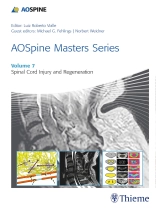<p><strong>World-renowned experts share the latest updates in translational research as well as surgical and nonsurgical strategies for treating spinal cord injury</strong></p><p>Spinal cord injury (SCI) is a devastating, clinically challenging injury, leading to varying degrees of neurological function impairment and paralysis. Underlying biological mechanisms either inhibit or promote new growth in the spinal cord. Researchers have been making important discoveries about how neurons and their axons grow in the central nervous system and why they fail to regenerate after SCI. Although progress has been steady, there remains an urgent need to address issues in acute management such as early decompression and the use of biologics, as well as potential solutions for regeneration.</p><p>Written by renowned experts in the ever-evolving field of SCI research and clinical practice, the 7th volume in the AOSpine Masters series is a state-of-the-art compendium on the latest in SCI diagnosis, spine surgery interventions, and long-term management. Each chapter contains pearls from leading spine specialists gleaned from the research laboratory and years of hands-on experience treating SCI patients in the emergency setting and long term.</p><p><strong>Key Features:</strong></p><ul><li>Pathobiology, assessment, and diagnostic considerations</li><li>The use of biomarkers as predictors of functional recovery</li><li>Surgical and nonsurgical interventions for traumatic SCI</li><li>The role of neural stem cells and biologics in spinal cord repair</li><li>Functional and epidural stimulation and brain-computer interfaces</li></ul><p><cite>The AOSpine Masters series</cite>, a copublication of Thieme and the AOSpine Foundation, addresses current clinical issues featuring international masters sharing their expertise in the core areas in the field. The goal of the series is to contribute to an evolving, dynamic model of evidence-based approach to spine care.</p><p>This essential textbook delivers invaluable insights to spine surgeons, spinal cord injury clinicians and researchers and trainees, from translational researchers to experienced researchers and clinicians experienced in the operative and non-operative management of spinal cord injury.</p>
Tabela de Conteúdo
<p>1. Pathobiology of Spinal Cord Injury<br>2. Assessment of Functional Status and Outcomes of Individuals with Traumatic Spinal Cord Injury<br>3. Serum and CSF Biomarkers to Predict Functional Recovery After Spinal Cord Injury<br>4. Magnetic Resonance Imaging of the Injured Spinal Cord: The Present and the Future<br>5. Acute Nonoperative Management of Traumatic Spinal Cord Injury: State of the Art<br>6. Role and Timing of Surgery for Traumatic Spinal Cord Injury: What Do We Know and What Should We Do?<br>7. Methylprednisolone As a Valid Option for Acute Spinal Cord Injury: A Reassessment of the Literature<br>8. Neuroprotection of the Injured Spinal Cord: What Does the Future Hold?<br>9. Hydrogel Biomaterials in Spinal Cord Repair and Regeneration<br>10. Neural Stem Cell Transplantation for Spinal Cord Repair<br>11. Strategies to Overcome the Inhibitory Environment of the Spinal Cord<br>12. Functional Electrical Stimulation and Neuromodulation Approaches to Enhance Recovery After Spinal Cord Injury<br>13. Advanced Rehabilitation Strategies for Individuals with Traumatic Spinal Cord Injury<br>14. Brain–Computer Interfaces to Enhance Function After Spinal Cord Injury</p>












